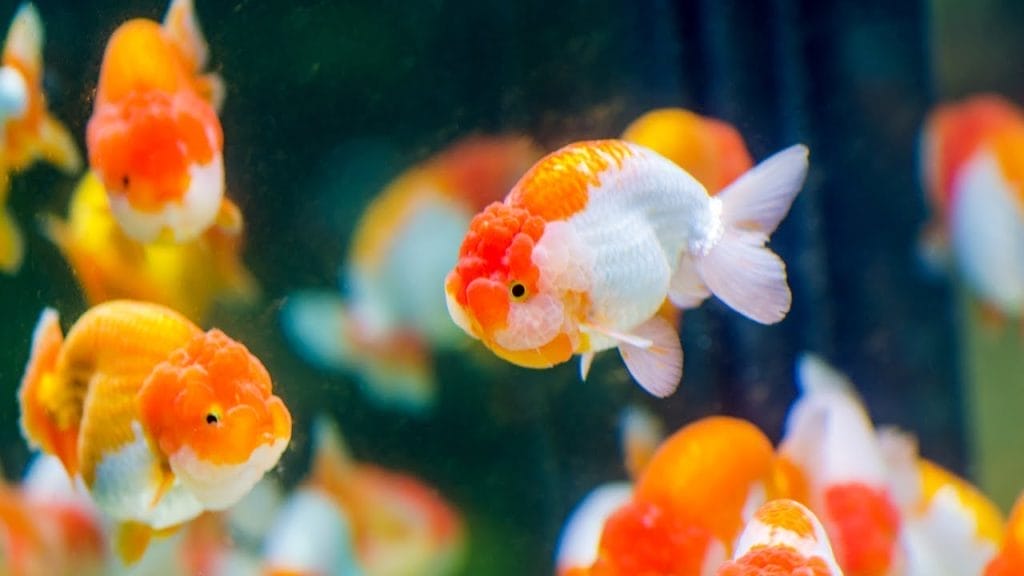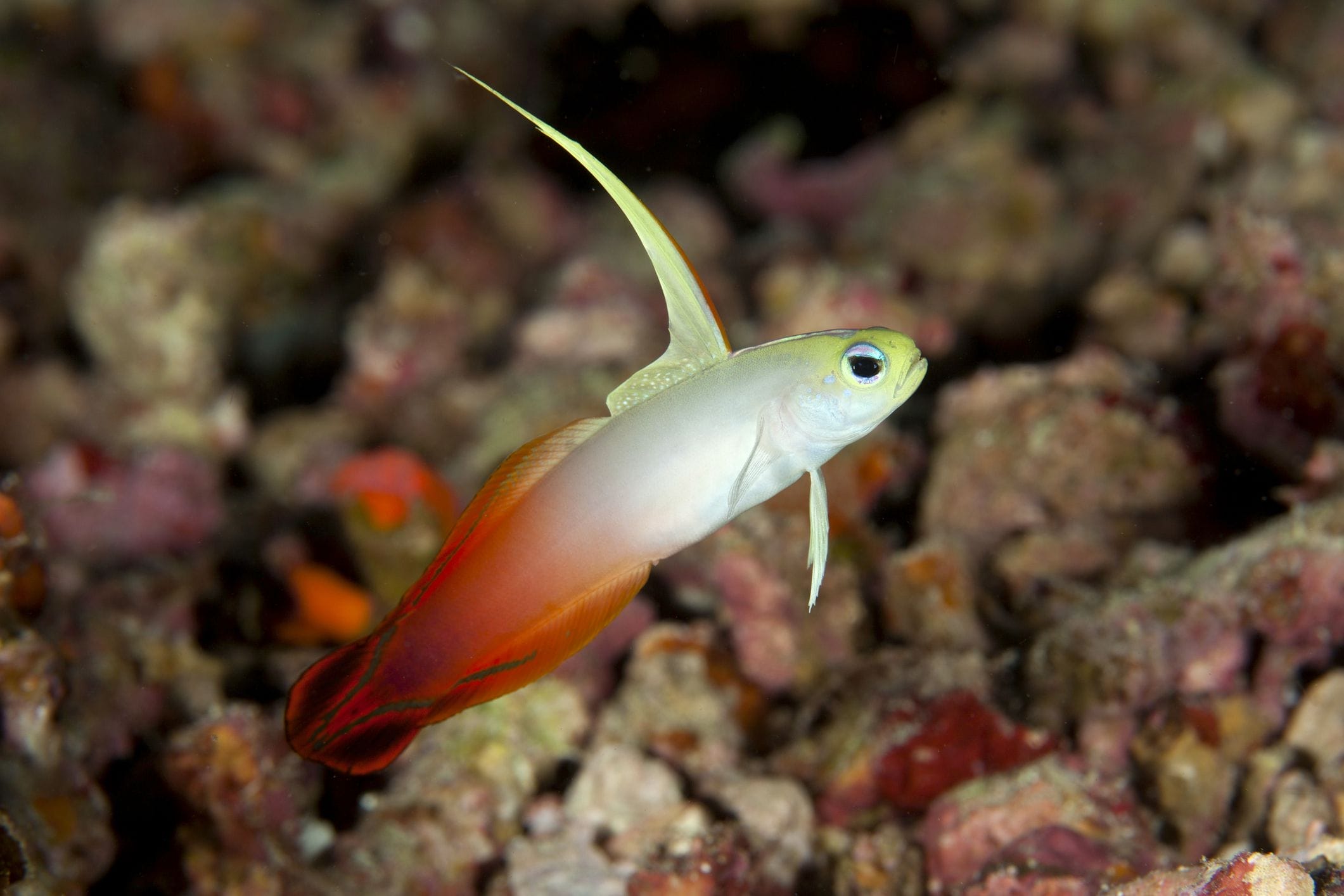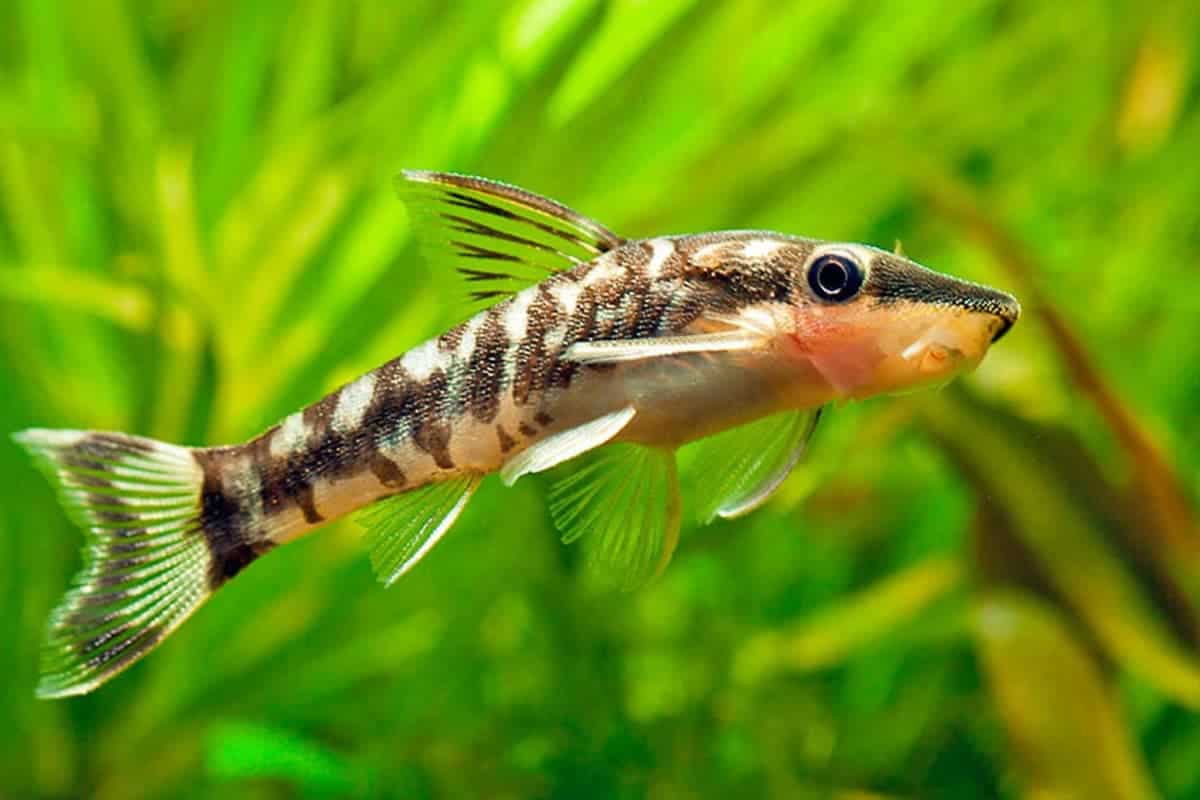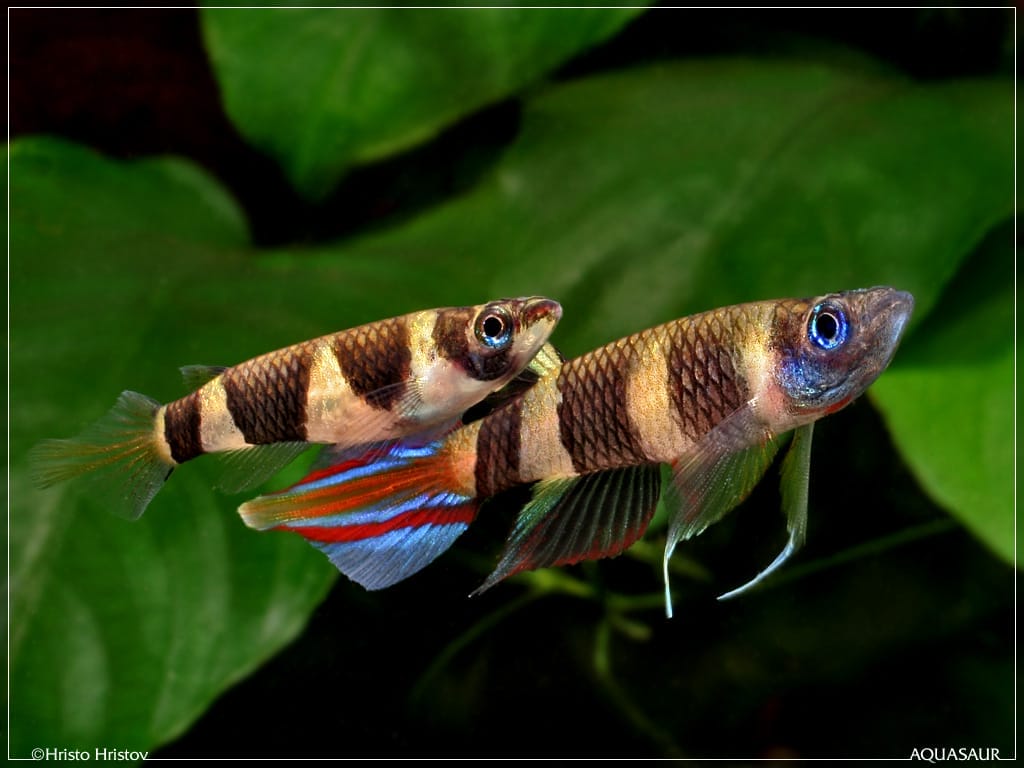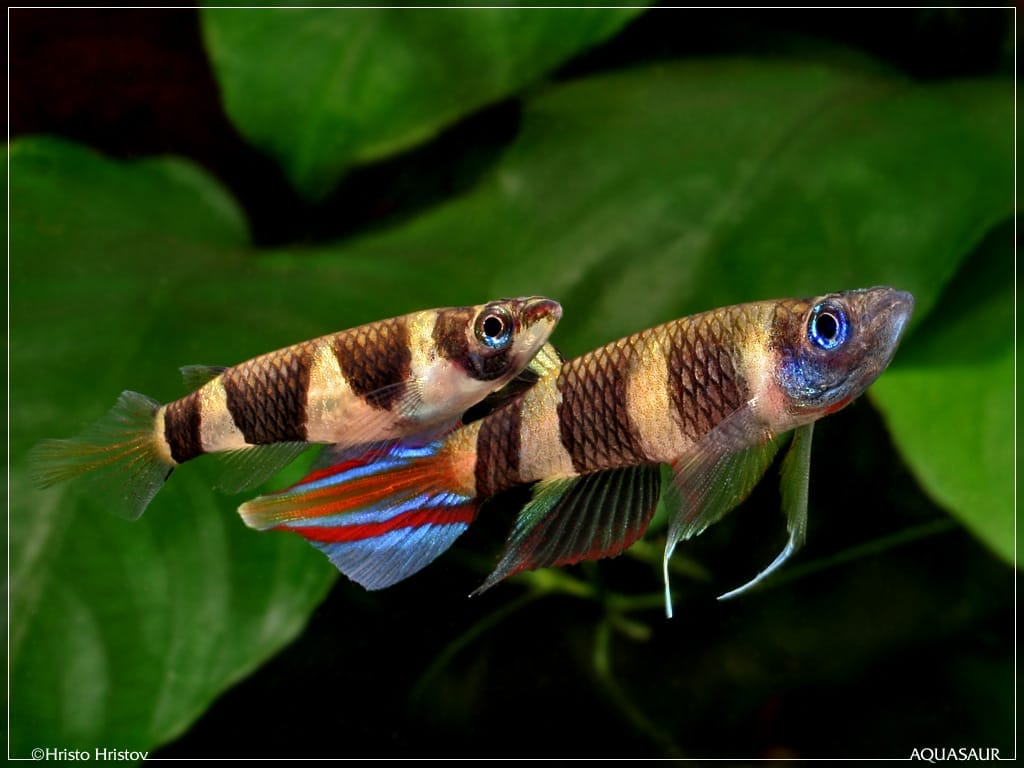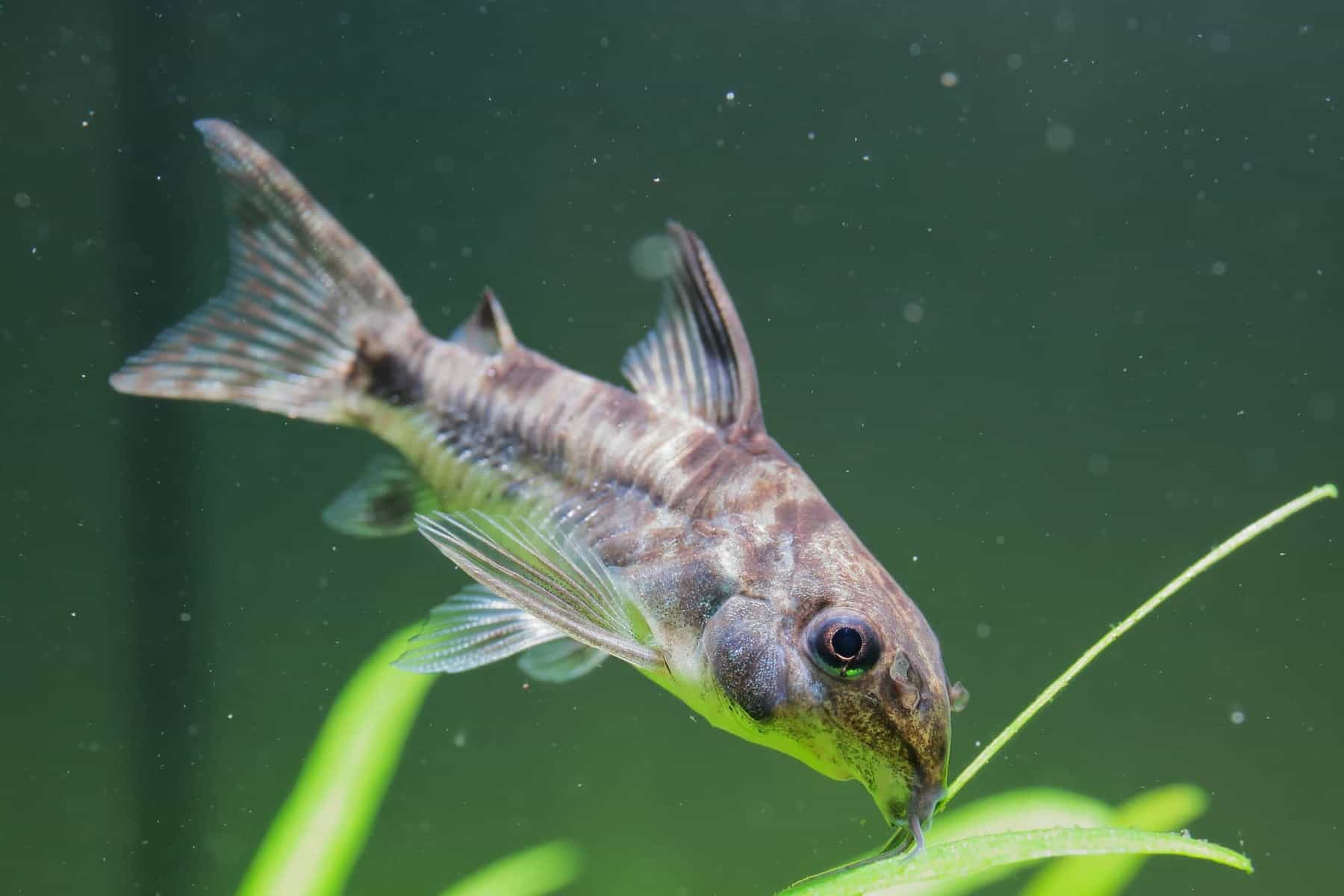
Flower Horn Fish: A Comprehensive Guide
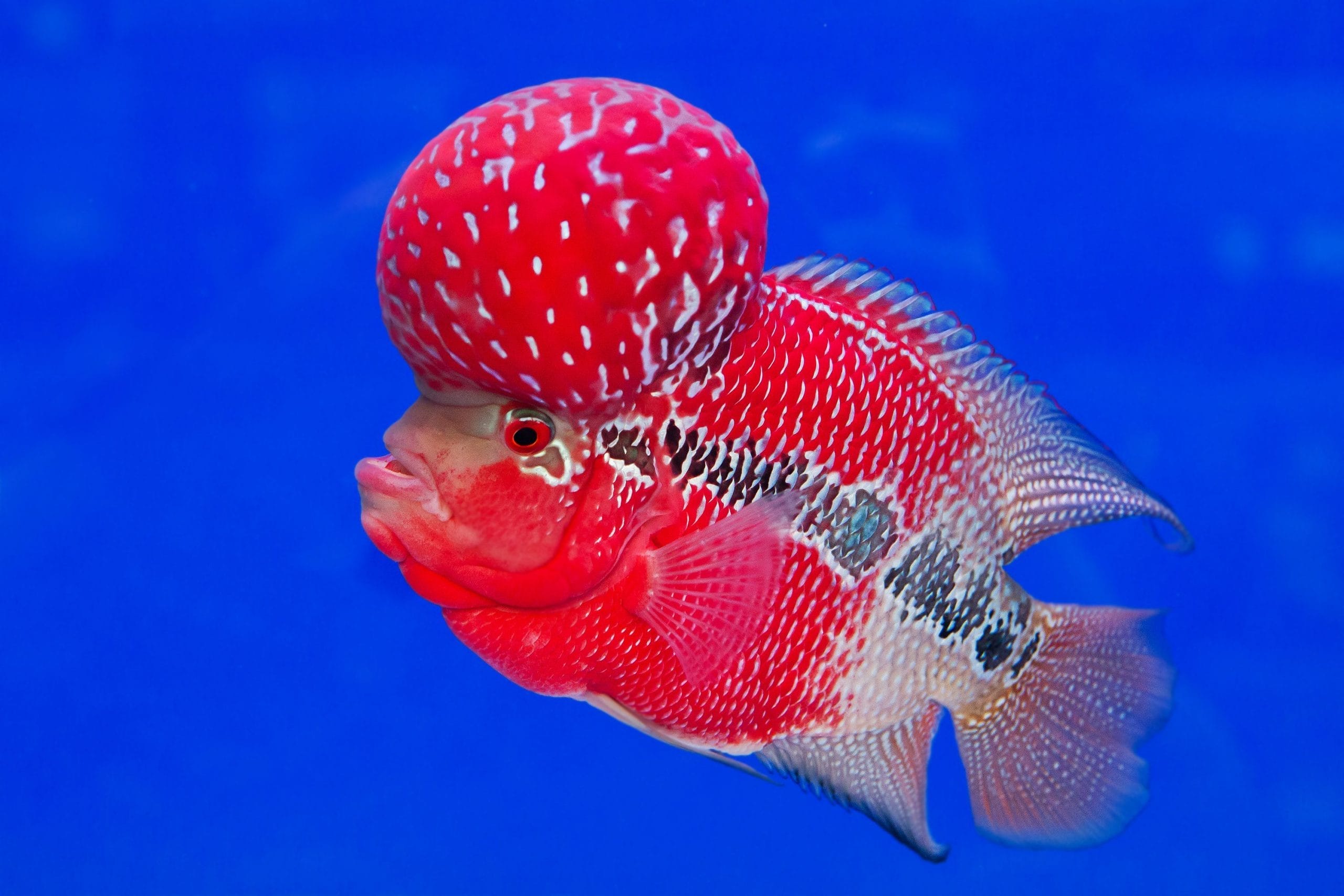
The Flowerhorn fish is a fascinating freshwater fish that more and more aquarium fish lovers are falling in love with. With their beautiful colors and interesting head shape, these fish are not caught from nature. Instead, they are bred in captivity, resulting in a wide variety of color patterns and fin shapes. Flowerhorn fish are known for their strong territorial behavior and can often be aggressive towards other fish, particularly betta fish female varieties. Despite this, many enthusiasts find their unique personalities and stunning appearance to be worth the extra effort in maintaining their tanks.
Instead, they were created through hybrid breeding, starting in Southeast Asia during the late 1990s. Because of their lively personalities, keeping Flowerhorn fish can be really rewarding, but they do require extra care in an aquarium.
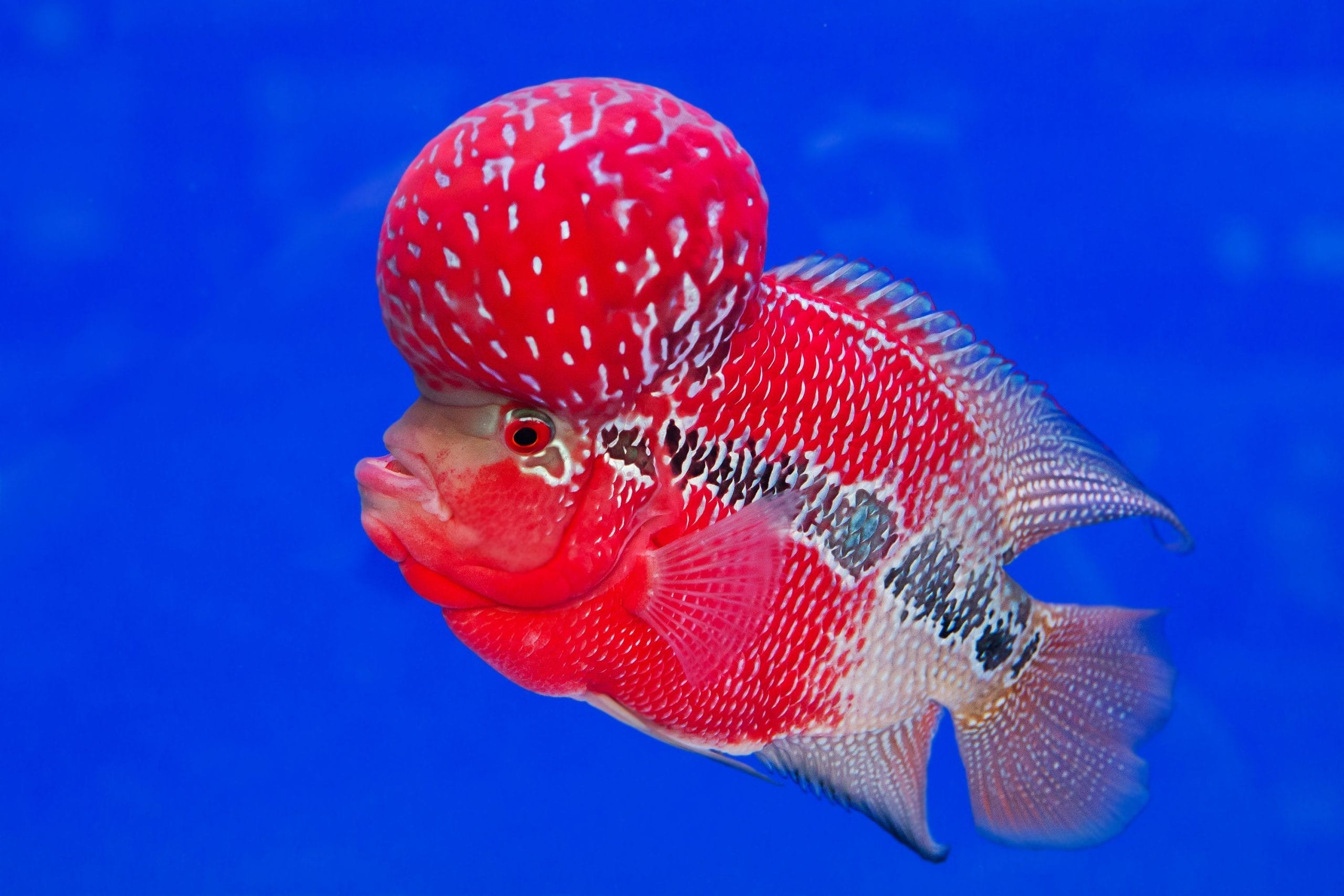
Read More : https://realacas.com/the-most-aggressive-freshwater-fish/
Understanding Flower Horn Fish
Flowerhorn fish, or Flowerhorn cichlids, are a new type of fish in the aquarium hobby. With origins that go back to the selective breeding done in Southeast Asia, breeders aimed to merge the best features of different Central American cichlids.
Through this careful breeding, we now have a fish that is visually breathtaking, boasting striking colors, a noticeable nuchal hump, and a lively, friendly personality. By learning about the origins and particular needs of Flowerhorn fish, we can make sure they thrive in an aquarium environment.
Origin and Unique Features
The Flowerhorn fish, as its name shows, is not a type of fish that occurs naturally. This special hybrid fish comes from dedicated breeders in Southeast Asia who, during the late 1990s, worked to mix the best traits of different Central American cichlids together. Some of the parent species used in making them are Red Devils, Trimacs, and other big, aggressive cichlids.
A main feature that stands out about the Flowerhorn is its noticeable nuchal hump, which is a fleshy bump on its head. The size and shape of this hump can differ a lot from one fish to another and is a key point in deciding how much they are worth in the hobby. With their striking colors, often a bright combination of reds, oranges, yellows, and blacks, they definitely make a stunning presence in any aquarium.
Yet, it’s vital to keep in mind that this hybrid origin means Flowerhorn fish have specific care needs that should be fulfilled to keep them healthy and happy. These needs usually blend together the requirements of their parent species, so it is very important for future owners to spend time researching and learning about what they need before getting one.
Varieties and Their Characteristics
Throughout the years, breeding has resulted in many different types of Flowerhorn cichlids, each one having its own special traits and looks. For instance, the Kamfa Flowerhorn stands out with its short body, bright colors, and very noticeable nuchal hump. In addition to that, the Zhen Zhu is another admired type, recognized for its beautiful scales that shine like jewels.
Because of the Red Devil cichlid, which is a main parent species, many Flowerhorn varieties show similar traits, especially in how they behave and their tendency to be aggressive. Several types, like the Golden Monkey Flowerhorn, display bright golden colors mixed with striking black patterns that look like a monkey’s face.
With all the various markings, patterns, and color combinations among Flowerhorn types, these fish remain popular with hobbyists who admire their amazing beauty. Yet, due to this variety, it is important to have responsible breeding methods to maintain the health and genetic diversity of these fascinating fish.
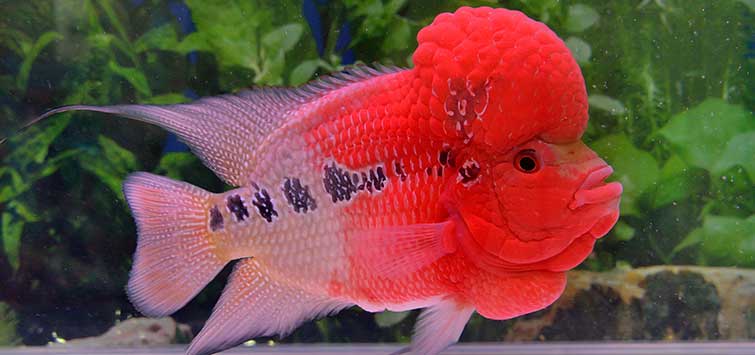
Setting Up the Perfect Habitat
Creating the right home for your Flowerhorn fish is really important for them to be healthy and for their beautiful looks. Choosing a big enough aquarium, keeping the water conditions just right, and adding the right equipment and decorations will help them live happily under your care.
When you set up their space, think about their natural behavior and how big they can get. Knowing that a clean and open habitat matters a lot, will help them live longer and lower the chances of any health issues related to stress.
Choosing the Right Aquarium Size
When talking about Flowerhorn fish, size matters—it’s important for both their health and how nice your aquarium looks. Think about their adult size, which can grow to 12 inches or more, when you choose a tank size. Choose at least a 55-gallon aquarium, but a larger tank, ideally 75 gallons or more, is better.
A larger tank brings several benefits. For more swimming space, that’s essential for these active fish. With a bigger tank, it also dilutes waste products more effectively, which leads to stable water parameters. Since Flowerhorns are messy eaters, they create a big bioload, so good filtration and regular water changes help maintain quality water quality.
By investing in a larger tank from the start, you won’t need to upgrade later. This choice greatly affects your Flowerhorn’s health and life. A spacious aquarium opens up possibilities for adding decorations and aquascaping, making a visually attractive and engaging area for your fish.
Water Conditions and Parameters
Maintaining good water quality is very important for your Flowerhorn’s health and happiness. Because they are sensitive to changes in water parameters, poor water quality can cause stress, sickness, and maybe even death. Start by making sure the water temperature stays within their preferred range of 80-85°F.
With checking the pH level regularly, you should aim for a slightly alkaline range of 7.4 to 8.0. With a reliable aquarium heater and a good water testing kit, you can keep an eye on these water parameters all the time. Doing weekly partial water changes of 25-50% helps to get rid of built-up nitrates and other harmful toxins.
With consistent water parameters, you can mimic their natural habitat and help your Flowerhorn do well in captivity. Also, don’t underestimate the need for a reliable filtration system to remove debris and keep the water clear. A healthy Flowerhorn is active and lively, and stable water conditions form the base for their overall well-being.
Essential Equipment and Decorations
To set up your Flowerhorn aquarium properly, using the right equipment and decorations is important for a safe, healthy, and enriching home. You will require the following:
- Filtration: For managing the waste from these large, messy eaters, a powerful filtration system like a canister filter or a big sponge filter is essential.
- Aeration: With an air pump and an airstone, you can boost oxygen levels in the water, which helps in their overall health and activity.
- Heating: Having a reliable aquarium heater will keep the water temperature stable, which is crucial for their well-being.
- Substrate: Select a substrate that won’t alter water parameters. Fine gravel or sand works well.
In addition, decorations should resemble their natural environment while offering enrichment. This can include:
- Rocks and Caves: By using rocks, caves, and driftwood, you can create hiding spots and territories that help to decrease stress and potential aggression.
- Open Swimming Space: Make sure there is plenty of open swimming space in the center and upper areas of the aquarium.
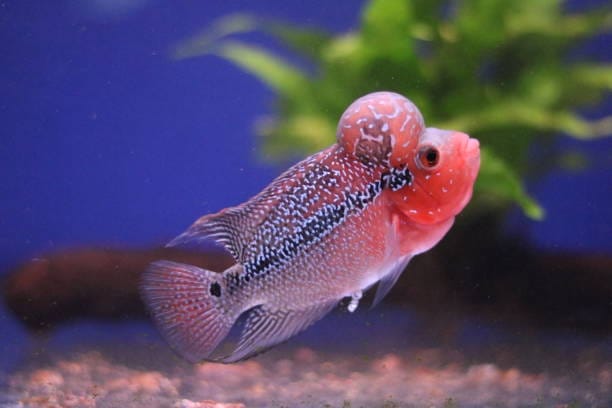
Comprehensive Care Guide
Taking care of your Flowerhorn fish is more than just creating a nice home for them. It also means knowing what they need to eat, keeping up with regular maintenance, and being ready to spot and fix any health problems quickly.
By following a steady routine in their care, you can really help them live longer and keep them as the lively, eye-catching main attraction in your aquarium. Always keep in mind that responsible fishkeeping includes fulfilling both their physical and mental needs.
Daily and Weekly Care Routines
Building a consistent care routine for your Flowerhorn is very important for keeping them healthy and avoiding any health issues. Every day, you should check the water temperature to make sure the heater works properly. Also, pay attention to your fish’s behavior for any unusual signs of illness, like lethargy, loss of appetite, or white spots on their body or fins.
During the week, you need to do partial water changes. These changes help in getting rid of built-up toxins like nitrates. Try to change about 25-50% of the water volume.
This depends on how many fish you have and how well your filtration system works. In addition, you can use an aquarium siphon to take out any leftover food or mess from the substrate while changing the water.
Furthermore, regularly cleaning the aquarium glass is a good idea. It helps in seeing inside clearly and keeps a nice environment for your Flowerhorn. By sticking to this routine, you can create a healthy space for your fish and avoid issues linked to poor water quality or a dirty aquarium.
Monitoring Health and Preventing Diseases
Maintaining the good health of your Flowerhorn fish means being attentive and proactive in avoiding diseases. Watching your fish often for any shifts in behavior or looks is very important. Common signs of health issues might be sluggishness, not eating, clamped fins, fast gill movement, or even white spots, which can mean Ich, a common fish parasite.
For excellent water quality, you should regularly do water changes and have a good filtration system as the best protection against diseases. If water quality is poor, it makes the fish weaker and more likely to get sick. Quarantining any new fish for at least two weeks before adding them to your main aquarium is wise to stop diseases from spreading.
Whenever you spot any signs of sickness, it’s vital to fix the problem right away. Talking to a skilled aquatic vet or an experienced fish keeper can help you find the right treatment options. Being quick in identifying and treating any issues could make all the difference for their recovery and in keeping the other tank residents safe from illnesses.
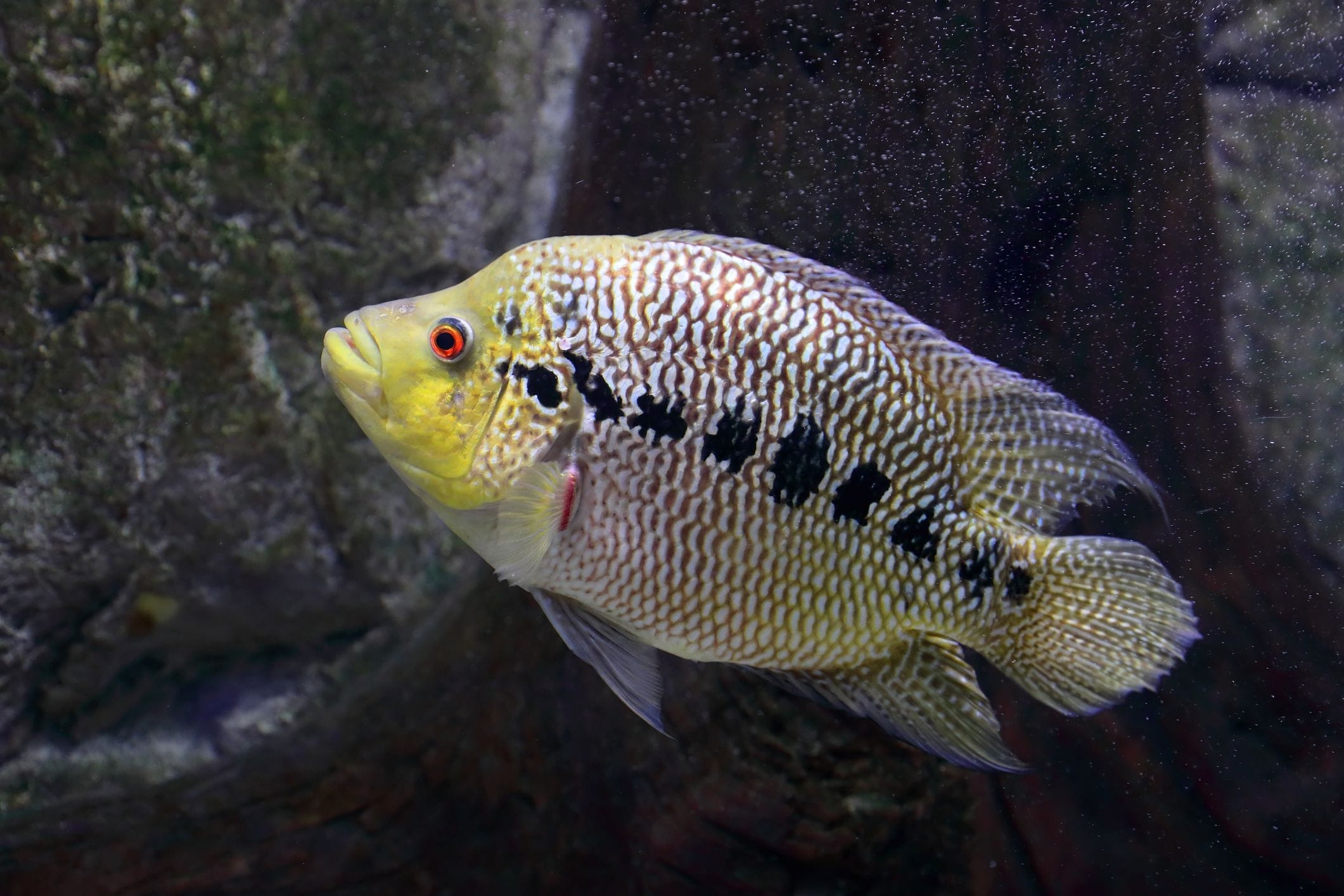
Diet and Nutrition
Offering a balanced and nutritious diet is important for the health, energy, and color of your Flowerhorn fish. These fish are omnivores and do well with a variety of food, which should include high-quality pellets specialized for Flowerhorn cichlids, protein-rich live foods, and some blanched vegetables now and then.
A varied diet that resembles their natural feeding can satisfy their nutritional needs and keep them active, which helps avoid boredom. Keep in mind that too much food can cause obesity and harm water quality, so serve them smaller portions, 2-3 times daily, that they can eat in a few minutes.
Best Foods for Flower Horn Fish
Feeding your Flowerhorn fish a varied and nutritious diet is important for their health, growth, and colorful appearance. Starting with high-quality pellets made for Flowerhorn cichlids should be the base of their meals. You should choose pellets that have plenty of protein, along with important vitamins and minerals that help with their well-being.
To enhance their diet, supplementing their pellet meals with live or frozen foods is a great idea. Live or frozen bloodworms, brine shrimp, and krill serve as fantastic protein sources and can improve their coloration. You might also give them small crustaceans or chopped earthworms as special snacks.
Although Flowerhorns mainly eat meat, adding small amounts of blanched vegetables to their diet can offer necessary vitamins and fiber. Blanched peas, zucchini slices, or spinach leaves should be included occasionally as extra nutrition. Lastly, don’t forget to take away any leftover food after feeding. This helps keep the water quality at its best.
Feeding Schedule and Portions
Following a consistent feeding schedule and giving the right amount of food is very important for your Flowerhorn fish. It’s usually best to feed adult fish two times a day, one in the morning and one in the evening. For juveniles, you could feed them more often, up to three times a day.
When figuring out how much to feed, look at their appetite. Pour in enough food that they can finish within 2-3 minutes, and avoid giving too much since that could lead to obesity, digestive problems, and poor water quality. If you see that food is left uneaten after feeding, think about changing the portions.
Keep in mind that their appetite might change based on their age, how active they are, and their overall health. Pay attention to how they react while eating and change their portions as necessary to make sure they get enough food without overfeeding.
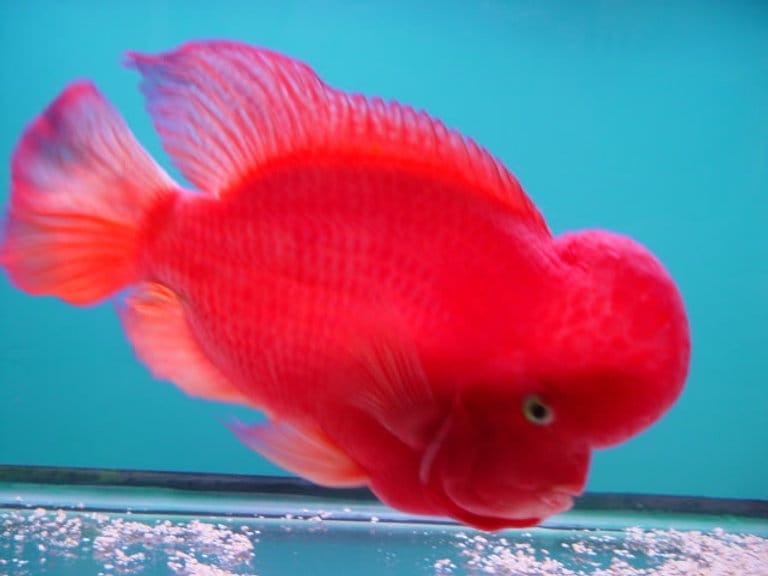
Behavior and Compatibility
Flowerhorn fish are famous for being smart and often lively. With their ability to recognize their owners, they can show playful actions, like following your fingers on the aquarium glass. In addition, though, their territorial behavior and possible aggression, mostly seen in males, need to be thought about seriously.
Because of their temperament, Flowerhorns should usually be kept alone, unless you own a very large aquarium. In that case, you would need to have carefully chosen tank mates and enough space for each fish to set up its own territory.
Understanding Aggression Levels
Flowerhorn cichlids are well-known for their interesting personalities. They show a mix of intelligence, playfulness, and a strong territorial nature. Due to this, they can be quite affectionate, often recognizing their owners. However, their natural aggression needs careful handling to keep a peaceful aquarium setting.
Because they are a hybrid type, their temperament can differ based on the traits they inherit from their parent cichlids. Generally, male Flowerhorns usually show more aggression than females, especially during breeding times. Their aggressive behavior can come out as fin-nipping, chasing, or head-butting, which might hurt less dominant tank mates.
If you think about keeping a Flowerhorn, it’s important to be aware of their temperament and the difficulties that come with their aggressive habits. Offering a large aquarium with plenty of hiding spots and choosing tank mates wisely can reduce aggression somewhat. Still, it’s essential to keep in mind that aggression is a natural part of their behavior.
Suitable Tank Mates
Finding suitable tank mates for Flowerhorn fish can be challenging due to their territorial nature and aggression levels. While it’s generally recommended to keep them alone, some aquarists have successfully kept Flowerhorns with other large, robust fish species in spacious aquariums.
Avoid tankmates that are known to be fin-nippers or overly aggressive, as this will inevitably trigger conflicts. Goldfish, small tetras, and other peaceful community fish are not suitable companions. Larger catfish like the Pictus Catfish can be an option, as they tend to inhabit different areas of the tank.
Here are a few potential tankmate options, but careful research and monitoring are crucial:
| Potential Tankmate | Compatibility Notes |
| Oscar (Astronotus) | Similar temperament, needs ample space |
| Jack Dempsey | Can coexist in large tanks with plenty of hiding spots |
| Green Terror | May trigger aggression in Flowerhorns |
| Pictus Catfish | Peaceful bottom-dweller, less likely to interact |
| Silver Dollar Fish | Peaceful and fast-moving, can work in large tanks |
Important Note: Introducing tankmates should always be done with caution. Observe their interactions closely, and be prepared to separate them if necessary.
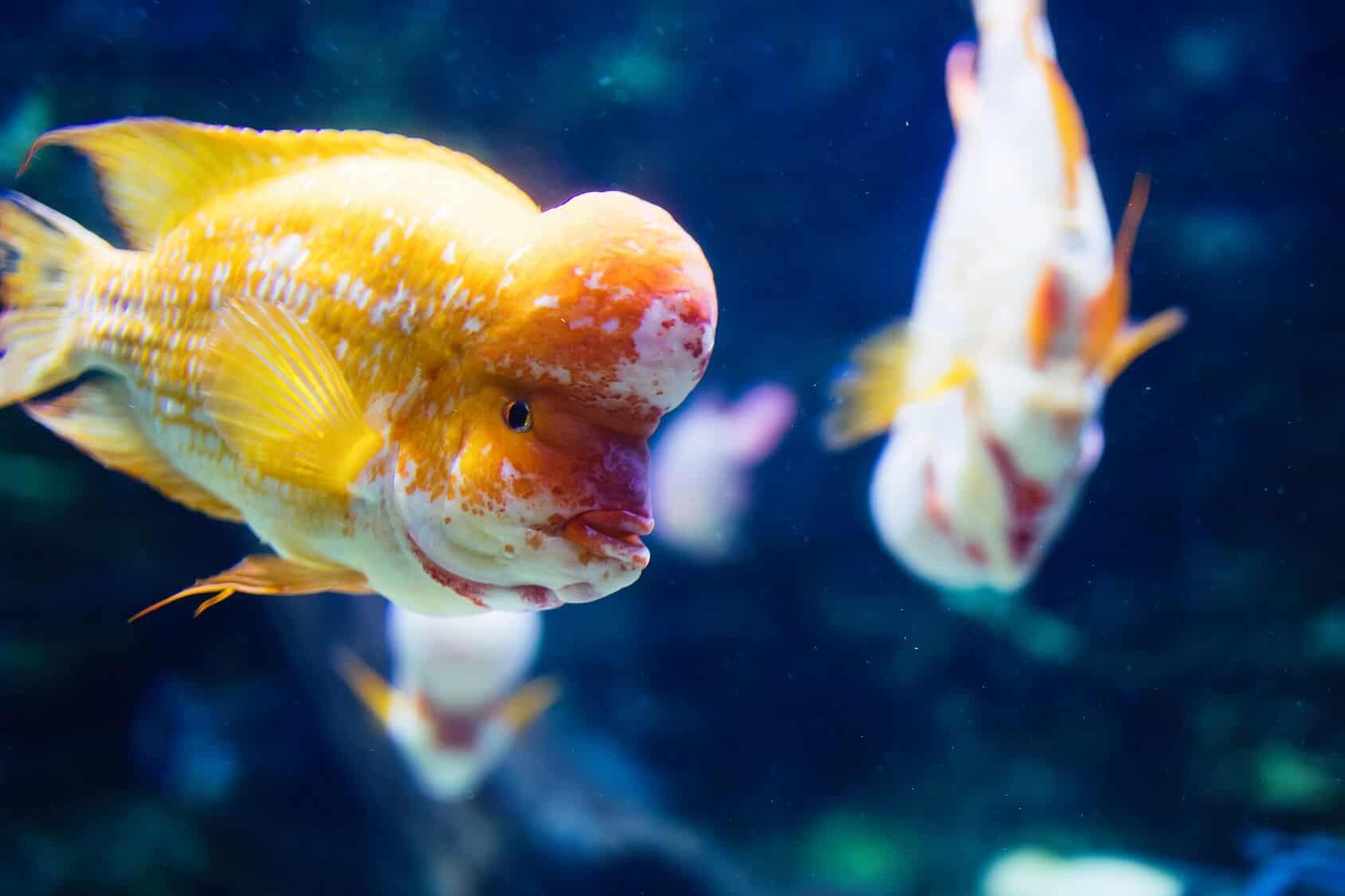
Breeding Flower Horn Fish
Breeding Flowerhorn fish can be both thrilling and tricky for experienced aquarium hobbyists. With a good understanding of their breeding habits, one must also make the right environment for spawning. Careful planning for the fry is important, too.
In addition to needing a dedicated breeding tank, it helps to watch carefully and manage everything to keep both the parents and their babies healthy.
Identifying Gender Differences
Before you start breeding Flowerhorn fish, it’s very important to know the gender of your fish. Although it’s not always simple, some key points can help you tell males from females. Typically, during breeding, males show brighter coloration and might develop white spots on their gill plates and head, known as breeding tubercles.
In comparison, females usually have rounder bodies, especially when they have eggs. Another way to tell is by looking at the dorsal fin. Males usually have longer, sharper dorsal fins, while females have shorter, rounder ones. Still, you should keep in mind that these signs aren’t always accurate since there might be differences in individual fish.
Also, by observing their behavior, you can find more hints. Males often act more aggressive and protective, particularly when spawning. If you see a couple cleaning a spot in the aquarium, like a flat rock or the glass, it might mean they are getting ready for spawning. If you’re still confused about the gender of your Flowerhorns, seek help from a knowledgeable aquatic veterinarian or a reliable breeder.
Creating Optimal Breeding Conditions
Creating good breeding conditions is very important for successful spawning in Flowerhorn fish. To start, set up a separate breeding tank that is bigger than their regular aquarium. It’s best to keep it simple with just smooth rocks or slate tiles because these provide better areas for cleaning and spawning surfaces.
About water quality, you really need to keep it clean. Do more regular water changes and use a good filtration system for the best water parameters. For better success in spawning, keep the water temperature a bit warmer than usual, around 82-84°F.
In the breeding tank, try to reduce the water flow. Strong currents can make it hard for them to breed and might even disturb the eggs. Make sure to feed them a diet filled with live or frozen food, like bloodworms and brine shrimp.
This will help the breeding pair to get ready for spawning. Observe them well for any signs of spawning, like cleaning a spot to lay eggs or showing strong courtship behaviors.

